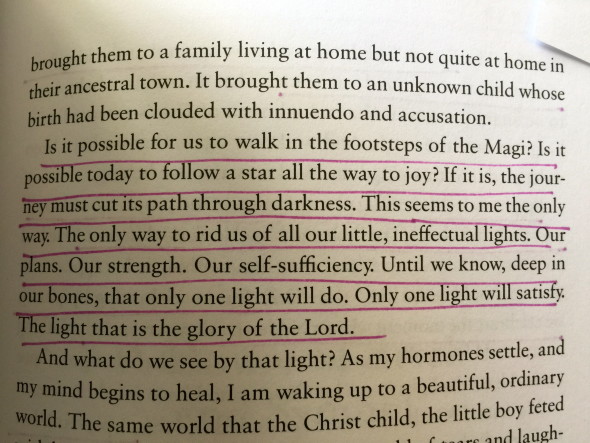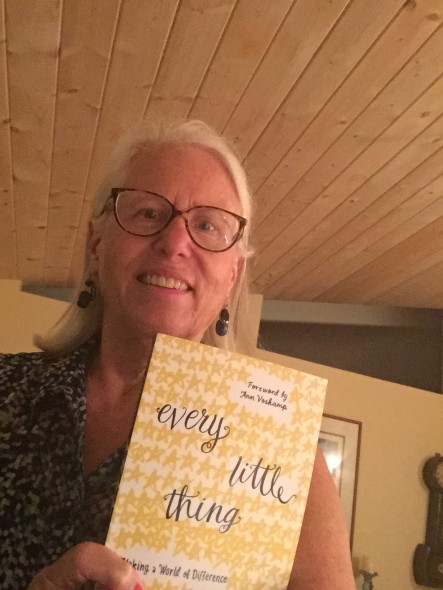Do you remember this lovely box, exploding with sunshine?
I surely do. It arrived on my doorstep in the earliest days of my recovery from nasty foot surgery, in mid-June, 2014. I’d injured myself and then discovered there was a whole lot more goin’ on in that dang foot than what I’d done to it. I was facing into a long recovery (much longer than we knew back then) and I was feeling L O W.
And then a lot of my internet friends did some remarkable things, and YOU were among the first. YOU sent me this box of yellow love. Every bright and lovely piece of this glory broke right through my sadness, my loneliness, my pain (both physical and emotional), and helped me to hang on during a long and difficult time in my life.
Now, sweetheart — look again at that date up there, okay? 2 0 1 4. Just a few short months after the journey you took with your boys, that long trek to Florida and back, the one you’ve written about so magnificently well in this new book of yours:
I had no idea you had struggled so earlier in that year. But somehow, it seemed important, as I write this strange epistle/review/blog post, it seemed important for me to remind you of how good, kind, thoughtful, insightful, intuitive and gifted you are even when you’re in the middle of a long, dark season in your own spiritual journey.
BTW, that cover? One of the best depictions of what’s actually inside the book that I’ve about ever seen. Genius! Not all of this tender journal was easy to read. I hate that you do battle with depression, that you sometimes have such a low view of your own, wonderful self. So some of this was painful to read.
But all of it was so good to read. Because what you come to, where you arrive, as you drive through the cold and the dark, as you deal with two pre-schoolers caged inside a small space for hours at a time, as you read your first book aloud in small town libraries and book stores and church basements, as you stay with friends and family, as you struggle to get those boys to sleep, as you eat at way too many MacDonald’s, and do a little bit (a very little bit) of sight-seeing — what you come to, in the end, is yourself.
And that, my dear, is the point. The goal. The reward. In this second book, you continue to do the good work started in “When We Were on Fire,” the good work of jettisoning the crap gathered in way too many rah-rah, emotion-heavy, guilt-inducing, misguided youth events. And you begin to see the light. The LIGHT. The truth that the Jesus walk is not so much about ‘re-discovering’ the emotional highs of adolescence, but about the steady, day-by-day commitment to putting one foot in front of the other.
It’s about seeing the light in small things, like the sun shining on your son’s hair, or smelling the first real cup of coffee after too many cups of tea, (or, if you’re a tea-drinker like I am, savoring the spicy scent of chai after too many stale coffee-breath greetings from friends!). It’s about accepting the truth that ‘success’ and ‘failure’ are pretty much meaningless terms when we’re talking about real life. It’s about letting go of the lists — you know the lists! Those things we’re ‘supposed’ to do to be ‘good’ Christians, the things we’re supposed to feel, or even believe, in order to pass muster.
It’s about letting go of all of that, and leaning hard into the truth of grace. It’s about learning to trust that there is not one thing we can do or not do that will make God love us any less or any more than God already does. It’s about breathing in and breathing out and saying the name of Jesus when we do. It’s about seeing and being seen. It’s about really, really, living. Not ‘living it up,’ not living on an emotional high forever, not even ‘living for Jesus,’ whatever the heck that means.
It’s about living real. Because I’m here to tell you, there is NOTHING more real than God, even when God seems absent, even when you’re driving in the dark of night, even when you’re struggling hard to re-create old experiences that simply are no longer possible or even desirable. You put it beautifully on page 225 (and a lot of other places, too, but this one’s the shortest:
“It’s not up to me to flip on the lights. the Light is already here.”
YES, Addie!! Yes, yes, yes. The Light is already here.
Thank you for writing this searingly honest book, for owning your own weaknesses, for showing us the shadow side. And here’s why I thank you — because with your exceptional writing grace, your skill, you illustrate this powerful truth: the shadow side is our teacher. Yes, there are parts of the shadow that we need to shine a bright, harsh light on, that we need to clean up and clear out. BUT . . . those shadow parts of us are also primary avenues through which God can show us more about grace, more about love, more about the human condition, more about truth than anywhere else. Like Barbara Brown Taylor (another one of my FAVES) in “Learning to Walk in the Dark,” you have shown us more about the light than any 1000 titles about sunshine-theology.
So, I thank you. I thank you for the box of sunshine at a dark time in my own journey. And I thank you for this beautiful book. May you be blessed beyond measure by the way people respond to it.
Much, much love,
Diana
Oh! Before I go, I wanted to share with you a couple of quotes that landed in my inbox today from a journal I subscribed to for many years, one that I used frequently in sermon prep and for devotional reading. It’s called “Weavings,” and if you don’t know it, I highly recommend it. These were in a monthly devo kinda thing, but each of them spoke to some of what “Night Driving” deals with, so I thought maybe you might enjoy them:
As people of faith, we need to remember that the resurrection tosses out all standard expectations and measurements of failure and success. Neither failure nor success is good or evil; both can result in growth, stagnation, or regression. In our struggle with failure and success, we may find a hidden strength as we commend our spirits to our Creator and seek to yield our lives to love. Our challenge is to have faith—in failure, in success, in whatever life brings. The unexpected turns, the painful endings, the precarious beginnings are all part of the path of faith, where we are reminded with each step that the resurrection did not happen only once long ago—it happens each day of our lives. — Jean M. Blomquist, “Weavings”
Pure faith hears the full silence of God, and believes—for the absence of God touches one’s thirst more than the presence of everything else. “In the desert we go on serving the God whom we do not see, loving [the God] whom we do not feel, adoring [the God] whom we do not understand, and thanking [the God] who has taken from us everything but [God’s self]” (Charles Cummings,Spirituality and Desert Experience). In time, the search becomes the goal, the longing becomes sufficient unto itself, and the perseverance transforms the meaning of success. Then some quiet evening, perhaps by full moon, it becomes strangely self-evident that we would not be searching had we not already been found. And the desert blooms when we find ourselves willing to be last—not because the last may become first, but because the game of “firsts” and “lasts” is no longer of interest.” — W. Paul Turner, “Weavings.”










































